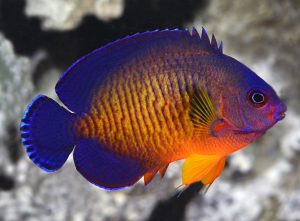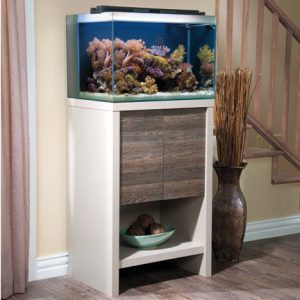

Tanks come in a variety of sizes and configurations. In general, freshwater aquariums are smaller and require less care, maintenance and expense. Many freshwater tanks are 55 gallons or smaller. Saltwater tanks are often larger – ranging from 29 to 200 gallons — to house multiple species or fish that reach larger sizes. Maintaining good water quality can be challenging in a marine aquarium, and larger tanks are less likely to have changes in temperature, oxygen, or levels of toxic compounds that are harmful to fish.
Freshwater tanks often have decorations (such as rocks, live or artificial plants, other structures) as part of the habitat. Some aquarium owners stock invertebrates along with their fish. Marine aquariums may be set up for fish only or as reef tanks featuring live rock or corals. Reef tanks offer the added benefit of mimicking the natural coral habitat of many tropical species but require special care in selecting “reef-safe” fish and providing proper lighting for coral growth.
Water Quality - Filtration
Regardless of tank size, both marine and freshwater aquaria require a filtration system to keep the water oxygenated and to remove toxic fish waste products. Pumps should be matched to the size of your aquarium: an effective pump will circulate your entire tank’s volume several times each hour.
There are several types of filters to remove different sizes and types of materials. Mesh filters remove larger particles and keep the water from becoming cloudy. Chemical filters remove waste products and elements that can be toxic to fish, such as chlorine and copper. These filters must be inspected frequently and cleaned or replaced as needed. Biological filtration uses beneficial bacterial to break down toxic fish waste (ammonia, nitrite) into compounds that generally do not harm fish. Unlike physical and chemical filters, biological filters take days or weeks to develop and function effectively.
Even with filtration, replace a portion of your aquarium’s water periodically. For tanks with many fish, changing up to 20% of the water weekly is recommended to maintain good water quality.
Aquarium Lighting
There several lighting options to highlight the fish or coral in your aquarium. Traditionally, tanks have used fluorescent lights, but LED bulbs are an energy-efficient choice that generate little heat. Many species from regions near the equator experience nearly equal days and nights and a 12-hour light/dark cycle is healthy. Avoid constant lighting that promotes algae. Many lights are “full spectrum” but bulbs are available in different “warm” and “cool” colors of different wavelengths. Tanks with living plants or coral may have one bulb for general lighting and another to promote growth.